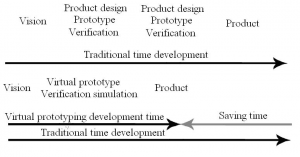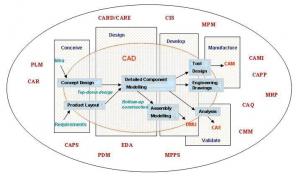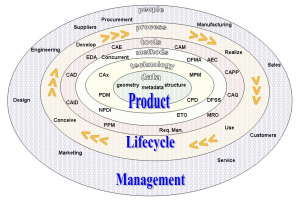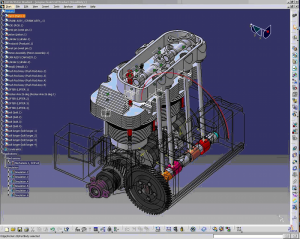Virtual prototyping utilize in industry production
13. December, 2010, Autor článku: Matej Juraj, Elektrotechnika
Ročník 3, číslo 12  Pridať príspevok
Pridať príspevok
 The paper deals with the need to close and virtual prototyping in practice today. The paper gives a breakdown used CAx systems as well as the use of software products in the design and manufacture cars. The last part of the contribution deals with the current requirements of industry for graduates of technical universities, who wish to work in the field of virtual prototyping.
The paper deals with the need to close and virtual prototyping in practice today. The paper gives a breakdown used CAx systems as well as the use of software products in the design and manufacture cars. The last part of the contribution deals with the current requirements of industry for graduates of technical universities, who wish to work in the field of virtual prototyping.
Introduction
With advances in computer technology is changing the procedure for making the final product. Creating a new product is closely linked with auxiliary design work such as: literary research (publications, patents), theoretical work (calculations, analysis), laboratory work (experiments), research and development work, not least addressing the product design and ergonomics. Only a few years ago, the life cycle began on paper freehand. Later redraw on the drawing boards and create the production drawings and assembled.
With advances in computer technology for hand-drawing has been transformed into a drawing using CAD systems to 3D modeling today and subsequent generation of drawings. Before the product is received into mass production, had to develop an initial project, which was transferred to pre-shape calculations and product design. Later followed by a technical project, which will determine the final shape of the product.
Followed by detailed technical documentation and parts manufacturing, assembly and installation verification tests on the real prototype. Further verification produced a series of product has passed the prescribed examinations. After the final adjustment of the technical documentation was followed by mass production. Product development is currently also subject to a similar procedure, but using CAx technology that we can significantly shorten development time.
1 CAX technology a necessity in today
Today must be provided in addition to the required quality, price and fast enough to develop a new product, which is increasingly subject to the fashion trends. Each stage of the development process is equally important, therefore it is necessary to shorten product development time by removing not one phase, but reducing the time taken for its implementation. Just time savings allow us to use CAx technology and in this way we can introduce modernization and new products to market in less time, but at a lower cost.
With the use of CAx technologies in product development is not necessary to perform the first verification tests on the real prototype, but the virtual prototype, which can then modify the desired parameters without costly and lengthy production real prototype. As documented by figure.1.1 virtual prototyping and the use of CAx technologies we are able to significantly reduce the time required for product development. [1]

Figure1.1 Comparison of traditional product development and virtual prototyping [1]
Use of computer technology is used in industry since the beginning of marketing. Nowadays, it seems very reasonable to propose complete machines, cars, houses, bridges … using virtual prototyping. Automation systems engineering (CAD/CAM/CAE/CIM), programming robots and flexible manufacturing processes, design and architecture to include other areas of virtual reality applications. Virtual prototyping is a logical extension of automation systems engineering work in modeling and visualization in real time, from product specifications, training documentation, analysis of ergonomic products, to production management.
By building a complete virtual reality suggests not incur any errors. Building material is subjected to different analysis. Before the status thus knows how to be part of the strain. We can simulate the construction process so we know exactly how much what we will ever need. Costs will be saved by the fact that we buy material only when we need him, or if its price is a bargain. Another plus is that we can for our new product walk, we can show the customer.
The presentation of our proposal in virtual reality to facilitate the approval of the proposal. The proposal can convert any simulation and is no longer therefore be to produce a prototype to test it and challenging. Nowadays, almost all automobile use virtual air tunnels. Virtual reality also used in interior design. Checks if the controls are properly positioned and whether everything is ergonomic. In the design phase of the virtual prototyping can save huge cost and therefore the industry quickly applied.
In the future, there is still a complete interactive design. Architect or designer is going through a virtual world and move the wall, moved windows and doors and make other adjustments to their virtual product.
2 Distribution of CAx technologies
Computer-aided technologies (CAx) is a broad term describing the use of computer technology to aid in the design, analysis, and manufacture of products.[3] Advanced CAx tools merge many different aspects of the product lifecycle management (PLM), including design, analysis using finite element analysis (FEA), manufacturing, production planning, product testing using virtual lab models and visualization, product documentation, product support, etc.
CAx encompasses a broad range of tools, both those commercially available and those which are proprietary to the engineering firm.[3] The term CAD/CAM (computer-aided design and computer-aided manufacturing) is also often used in the context of a software tool covering a number of engineering functions.[3]
Tab. 2.1 CAx Technologies Summary
| Computer-aided design (CAD) | Computer numerical controlled (CNC) |
| Computer-aided architectural design (CAAD) | Computational fluid dynamics (CFD) |
| Computer-aided design and drafting (CADD) | Electronic design automation (EDA) |
| Computer-aided process planning (CAPP) | Enterprise resource planning (ERP) |
| Computer-aided quality assurance (CAQ) | Finite element analysis (FEA) |
| Computer-aided reporting (CAR) | Knowledge-based engineering (KBE) |
| Computer-aided requirements capture (CAR) | Manufacturing process management (MPM) |
| Computer-aided rule definition (CARD) | Manufacturing process planning (MPP) |
| Computer-aided rule execution (CARE) | Material requirements planning (MRP) |
| Computer-aided software engineering (CASE) | Manufacturing resource planning (MRP II) |
| Component information system (CIS) | Product data management (PDM) |
| Computer-integrated manufacturing (CIM) | Product lifecycle management (PLM) |
| Computer-aided manufacture (CAM) |

Figure 2.1 Illustration of the interaction of the various computer-aided technologies. [3]

Figure 2.2 CAx tools in the context of product lifecycle management [3]
3 Computer model and car production
In the production of the new prototype is now exclusively used structurally complex drawings and models in the actual size of plaster or clay. Upon completion of the prototype vehicles were tested with actual tests on vehicle safety. Vehicle design in the future should be to the smallest detail has carried through virtual prototyping.
The main advantage of virtual design is that it is no longer necessary to build a prototype vehicle intended for initial tests, and any adjustments will be made directly in virtual reality by simulation models. Every part of the next car may be tested separately, but on the whole. Designers can use the database design solutions to previous models, and if they do not comply, they can modify them according to specified requirements. [5] Firstly, the proposed body, depending on the vehicle. Interior design using software but it also has its weakness – the designer can not touch used material. Software companies are already working on goggles and gloves, which will be virtually touch the car’s interior. [5]
Most complicated structure is an internal combustion engine, which develops up to four years. Internal combustion engine needs to be redesigned to the smallest detail. Each engine component can be increased, and also three-dimensional look. Where appropriate it the designer can change or even completely replaced. With virtual prototyping is to determine the functionality, and also to engine designed to meet the dimensional requirements. [5]

Figure 3.1 Combustion engine CAD model[6]
Tests have already produced prototypes are very expensive. Reducing the cost of testing can reduce the appropriate software. Aerodynamic characteristics of the vehicle no longer be studied in the tunnel air stream as yet, but will be able to carry through simulations in the virtual prototyping. Virtual cars can be tested in unlimited quantities and in any kind of tests. The simulation model must be sufficiently precise and not identical with the real vehicle. [5] The final test is probably the future will be verified on a real vehicle.
In 2007 the automobile was in Sindelfingen very first car, whose design was made completely by computer. It was a Mercedes C class and structure was created 2 130 GB of data, more than 450 DVDs. [5] Virtual prototyping is increasingly used in the development cars and replaced the expensive construction of physical clay models. The future of virtual construction leads to the selection of product to customer and trying before its manufacture.
4 Requirements for graduates industry
University graduates who want to enforce in practice in the field of virtual prototyping must be controlled foundations CAx technologies with which they must be able to draw up a simulation model of the product and make it to the required analysis. The current production of semi-intensive products together with customer requirements to reduce development time respectively. Pproduction is not possible without the use of CAD / CAM systems. Knowledge of 3D CAD systems is becoming a standard necessity for graduates of technical universities worldwide.
Conclusion
Product design as well as its entire development and production is today can not do without the use of appropriate software products, especially CAx technology whereby we can product the virtual modeled, simulating his professional activity as well as virtual test without using a physical model. Practical experience shows that the final test must still be implemented on real product, it can be neglected in modeling the various influences that affect the virtual simulation model.
Nevertheless, virtual prototyping can significantly reduce the time needed to develop the product. Virtual prototyping can therefore shorten the development stages and save a lot of money in the production of several prototypes that were needed for physical testing of the product.
Acknowledgement
This article has been accomplished under grant program to support young researchers.
References
- http://fstroj.utc.sk/journal/sk/2006/lichotova2.pdf
- Fabian, M., Spišák, E. :Navrhování a výroba s pomocí CA.. technológií, ISBN 978-80-85825-65-7, Brno 2009
- http://en.wikipedia.org/wiki/Computer-aided_technologies
- http://www.coe.org/coldfusion/newsnet/Dec04/images/figure14.gif
- http://automix.atlas.sk/tuning/244740/vyroba-aut-len-pomocou-pocitacov
- http://www.engineering.com/CATIACommunity/2008EngineeringVISIONGrant/articl eType/ArticleView/articleId/374/Sample-Student-Projects–VW-Engine-Three-Peaks-GIS-Data-3-Axis-CNC.aspx
Co-authors of this paper are Vladimír Goga, Tomáš Jediný, Slovak University of Technology in Bratislava, Faculty of Electrical Engineering and Information Technology, Department of Mechanics, Ilkovičova 3, 812 19 Bratislava 1

